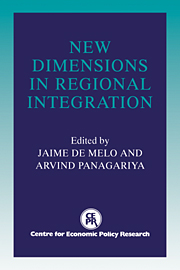Book contents
- Frontmatter
- Contents
- List of figures
- List of tables
- Preface
- Foreword
- Acknowledgements
- List of conference participants
- PART ONE SYSTEMIC ISSUES
- PART TWO COUNTRY ISSUES
- 6 The new regionalism: a country perspective
- Discussion
- 7 The European Community: a case of successful integration?
- Discussion
- 8 Regional integration in Sub-Saharan Africa: past experience and future prospects
- Discussion
- 9 Latin America's integration and the multilateral trading system
- Discussion
- 10 Regional integration in Eastern Europe: prospects for integration within the region and with the European Community
- Discussion
- 11 Regional trade arrangements in North America: CUSTA and NAFTA
- Discussion
- 12 Trading blocs and East Asia
- Discussion
- 13 Prospects for regional integration in the Middle East
- Discussion
- Round Table Discussion
- Index
6 - The new regionalism: a country perspective
Published online by Cambridge University Press: 04 May 2010
- Frontmatter
- Contents
- List of figures
- List of tables
- Preface
- Foreword
- Acknowledgements
- List of conference participants
- PART ONE SYSTEMIC ISSUES
- PART TWO COUNTRY ISSUES
- 6 The new regionalism: a country perspective
- Discussion
- 7 The European Community: a case of successful integration?
- Discussion
- 8 Regional integration in Sub-Saharan Africa: past experience and future prospects
- Discussion
- 9 Latin America's integration and the multilateral trading system
- Discussion
- 10 Regional integration in Eastern Europe: prospects for integration within the region and with the European Community
- Discussion
- 11 Regional trade arrangements in North America: CUSTA and NAFTA
- Discussion
- 12 Trading blocs and East Asia
- Discussion
- 13 Prospects for regional integration in the Middle East
- Discussion
- Round Table Discussion
- Index
Summary
Introduction
Three decades ago, under the impetus of European arrangements, the developing world launched the first wave of regional integration (RI). Free-trade areas (FTAs) and customs unions (CUs) mushroomed in Latin America and Africa. Unfortunately, expectations of economic development through RI were not realised, and two decades later virtually all regional arrangements among developing countries were judged as failures.
By the early 1980s, multilateral tariff cutting by developed countries and unilateral trade liberalisation (UTL) by developing countries had substantially weakened the case for regional arrangements. Yet, paradoxically, it is then that a second round of regionalism got under way. More arrangements (eight) were signed during the 1980s than during the 1960s, and still more (half a dozen or so) are under consideration. The GATT process is running out of steam and many countries are turning back to the bilateral alternative.
From the viewpoint of developing countries, the current regionalism differs from the regionalism of the 1960s in two important respects. First, the regionalism of the 1960s represented an extension of the importsubstitution- industrialisation strategy from the national to the regional level and was therefore inward-looking. The current regionalism is by contrast taking place in an environment of outward-oriented policies. Second, in the 1960s, developing countries pursued RI exclusively with other developing countries. Today these countries, especially those in Latin America, have their eyes on integration with large, developed countries.
In this chapter, we review and extend the theory of RI and evaluate empirically its contribution to growth. Our objective is to assess the benefits of RI from the viewpoint of participating countries rather than the world as a whole.
- Type
- Chapter
- Information
- New Dimensions in Regional Integration , pp. 159 - 193Publisher: Cambridge University PressPrint publication year: 1993
- 29
- Cited by



